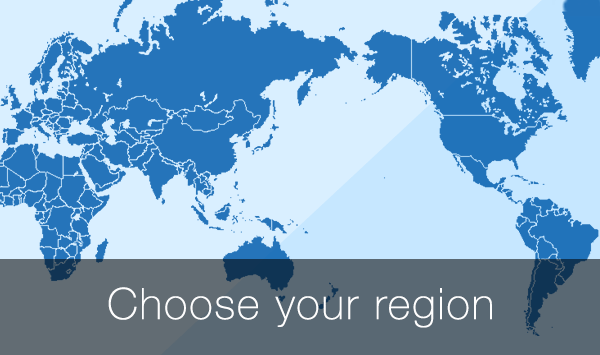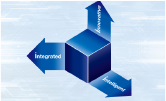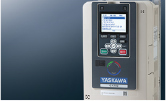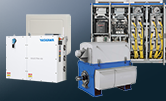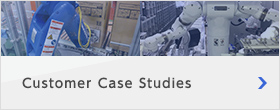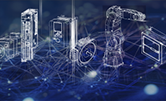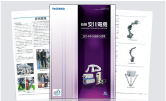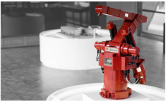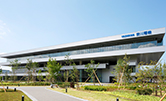Representative Director
President
Hiroshi Ogasawara
In the economic situation surrounding Yaskawa in 2017, the global situation was that the Chinese economy recovered and, although it showed a trend towards deceleration in the latter half of the year, for the most part it remained stable. The U.S. economy was supported by robust personal consumption and a gradual economic expansion continued, particularly for domestic demand. In Europe, there was concern that there would be a downturn due to the strong Euro, but an expansion in exports sustained gentle economic recovery. In Japan, the recovery of the global economy from the latter half of 2016 resulted in manufacturing industries in particular seeing a continuing trend of export expansion and a steady recovery in capital investment. The expansion of the Japanese economy was comparable to that during the so-called “Izanagi Boom” period of postwar growth.
In these conditions, Yaskawa is now working under the “Dash 25” medium-term business plan (FY2016 to FY2018) as the first step towards the achievement of the “Vision 2025” long-term business plan that was announced in 2015 at the 100th anniversary of the establishment of the company. In order to become the leader in our core business sectors, we are working to further advance and develop the core technologies we have developed so far (for servos, AC drives, and robots), by aiming to expand our business with a focus on our mechatronics business and also into new areas and markets such as clean power business and Humatronics business. In particular, for our mechatronics business, we have launched “i3-Mechatronics” (pronounced i cube mechatronics) our new solution concept. One of the goals stated in our “Vision 2025” is to “Deliver revolutionary industrial automation.” As one initiative for this, the concept of i3-Mechatronics is to add digital data management to our conventional solutions that are based on products such as servos, AC drives and robots, for further advancement and implementation. We will create new value for customers by bringing together digital data solutions to offer a total solution.
The technology development for each industrial sector in 2017 was as follows.
In our motion control business, we expanded and improved the lineups of our main Σ-7 series AC servo drives and MP3000 series machine controllers and expanded the range of applications for them. In addition, we launched the Σ-7F integrated servo motor, which achieves the ultimate electrical and mechanical integration by integrating the servo motor and servo amplifier functions into a single unit in the first such product in the world to include a Gallium Nitride (GaN) power semiconductor. We also launched the very small Σ-7mini motor, which includes reflection-type encoder technology and responds to the requirements for high precision and high outputs. In addition, we promoted our development of products for specific applications, such as with the market launch of the CR700 AC drives for cranes.
In our robotics business, we expanded and improved the lineups of our MOTOMAN-GP series (for handling applications), SP series (for spot welding applications), and PH series (for handling between press processes) and responded to the requirements for the wide variety of customer production line configurations. In addition, we launched the MotoMINI, which is the smallest and lightest robot in the industry and makes it easy to construct flexible production equipment, making it the optimal choice for the automation of the production of small components. We also launched the YRC1000micro small-sized robot controller and the MOTOMAN-HC10 collaborative robot, which can be installed without a safety barrier and makes teaching easy.
In our system engineering business, we developed a permanent magnet type generator in response to the global trend towards the use of natural energy and the promotion of energy-saving and energy utilization and we reinforced our “Clean power business” with steps such as responding to the demand for larger sized wind power generation. In drives for marine vessels, we developed a DC bus line system in response to the requirements for the use of electric motors on ship propulsion systems.
In the area of research and development, we aimed for “Human & Eco Mechatronics creation” that is good for both people and the Earth and promoted the development of various different technologies such as technology to automatically optimize robot work procedures, an AI picking function that independently learns the various methods for grasping objects, technology for teaching robots skilled work through demonstration and matrix converter technology using bi-directional GaN devices. Furthermore, we also launched the CoCoroe AR2 arm rehabilitation robot and CoCoroe AAD ankle assist device as a result of the demonstration verification we promoted for our Humatronics business at the model project to support the development of nursing robots in Kitakyushu city.
Yaskawa will continue to aim to create new value for society by further advancing the core technologies of the company and also by realizing a Yaskawa version of Industrie 4.0 that uses network technologies such as the IoT and AI. We will also work to expand our clean power business around the world, such as in environmental energy, and to develop Humatronics devices. You can count on Yaskawa to create solutions as we continue to take on the challenges of new business domains.
In the demand for robots, the main objective up until now has been the reduction of costs through automation. However, as a shortage of labor has become a pressing issue, the demand for production workplace automation as a solution to this is currently increasing rapidly. Furthermore, the continued growth of the Chinese economy has led to an expansion of the demand for robots in a wide range of sectors such as automobile related markets, smartphones, computers, household electrical goods, communications equipment and the handling of heavy objects.
In response to these changes in the market, Yaskawa operates robot centers around the world that can verify the introduction of customer applications in advance and has strengthened the company’s initiatives for the rapid provision of the optimal solutions to solve the problems experienced by customers.
In China, Yaskawa established a joint venture to develop industrial robot business with “Shenzhen Everwin Precision Technology Co., Ltd.,” which is a major manufacturer of smartphone related devices. This venture aims to develop and offer the optimal robots for smartphone manufacturing.
Yaskawa booth at 44th International
Home Care & Rehabilitation Exhibition
CoCoroe AR2 arm rehabilitation robot
Yaskawa attended the 44th International Home Care & Rehabilitation Exhibition H.C.R. 2017 (September 27 to 29, 2017, Tokyo Big Sight), and introduced our Humatronics business initiatives in the medical care and welfare sector, as stated in Yaskawa’s Vision 2025. This exhibition is the largest exhibition of welfare equipment in Asia, with more than 120,000 participants. The large number of customers showed their interest in CoCoroe.
The products shown at the exhibition included the CoCoroe AR2 arm rehabilitation robot that supports repetitive facilitative exercise, which was launched in September 2017, and the ReWalk walking assist equipment for persons with spinal cord injuries, which is already on sale. Products that are planned to launch were also displayed; an ankle device that assists in walking rehabilitation, a transfer assist device that aims to reduce the burden on carers and a walking assist device that supports walking.
Demonstrations were given of each device. The medical care and welfare related personnel also used the devices so that they could understand the merits and functions of the products.
During the exhibition, awareness of the Yaskawa CoCoroe brand of nursing care and rehabilitation products was spread among a large number of hospital and facility related users and sales agencies. At the same time, useful information for product improvement and new product development was also collected by asking visitors about the methods of usage and requirements at their facilities.

Biomedical robot MOTOMAN-CSDA10F
In the biomedical sector of drug discovery, drug production, and clinical examinations, dual arm biomedical robot systems have been developed for robots to support or replace repetitive and dangerous work. In order to use robots in the biomedical sector, it becomes necessary to perform complex teaching work such as for the handling of apparatus and equipment. However, researchers in the biomedical sector are unfamiliar with the operation of robots, so this was a barrier to robot installation.
In response to this, the burden of the work to teach biomedical robot systems was reduced with the “ProtocolMaker” software to simplify robot teaching and by having a function (the Path Planning function) to automatically generate the robot motion trajectory to avoid interference.
This development received the “22nd Technical Innovations Award” from the Robotics Society of Japan as a recognition of the practicability and novel technologies. This article describes the configuration of biomedical robot systems and the function to reduce the teaching workload, previous results in the application to bio experiments and the future outlook for the technology.
 Region
Region



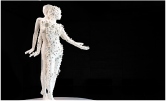 Principles & vision
Principles & vision
 Procurement
Procurement
 Sustainability for the Yaskawa Group
Sustainability for the Yaskawa Group
 Customer satisfaction
Customer satisfaction
 Supply chain
Supply chain
 Social contribution
Social contribution
 Compliance & risk management
Compliance & risk management


